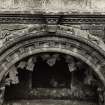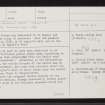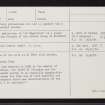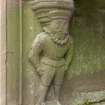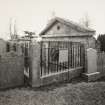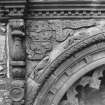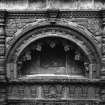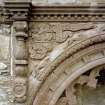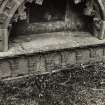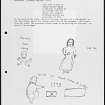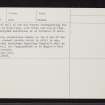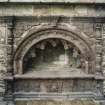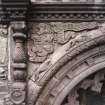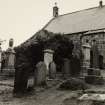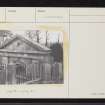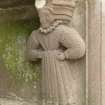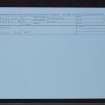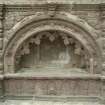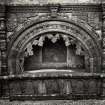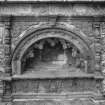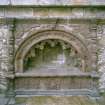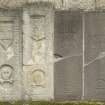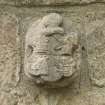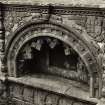Pricing Change
New pricing for orders of material from this site will come into place shortly. Charges for supply of digital images, digitisation on demand, prints and licensing will be altered.
Tarves, Kirkbrae, Tarves Old Parish Church And Tolquhon Aisle
Burial Aisle (Medieval), Church (Medieval), Tomb (16th Century)
Site Name Tarves, Kirkbrae, Tarves Old Parish Church And Tolquhon Aisle
Classification Burial Aisle (Medieval), Church (Medieval), Tomb (16th Century)
Alternative Name(s) Parish Church Of St Englat; Tolquhon Monument; Tolquhon Tomb; Tanglan's Well; Englat's Well; Tanglandford; St Englat's Ford
Canmore ID 19831
Site Number NJ83SE 32
NGR NJ 86906 31179
Datum OSGB36 - NGR
Permalink http://canmore.org.uk/site/19831
- Council Aberdeenshire
- Parish Tarves
- Former Region Grampian
- Former District Gordon
- Former County Aberdeenshire
Churchyard, which contains Craig slab of 1583 and some 18th century stones, also houses the Tolquhon Monument of 1589 (Thomas Leper). For William Forbes of Tolquhon and his wife, Elizabeth Gordon, it is all that survives of the south aisle of the old kirk. A marvellous blend of Gothic and Renaissance motifs, a worthy reflection of the life of the builder of
Tolquhon. (Pediment over probably 1798.)
Taken from "Aberdeenshire: Donside and Strathbogie - An Illustrated Architectural Guide", by Ian Shepherd, 2006. Published by the Rutland Press http://www.rias.org.uk
NJ83SE 32 86906 31179
For (successor and present) Tarves parish Church (NJ 86904 31196), see NJ83SE 48.00.
See also NJ82NE 1.
The church of Tarves was dedicated to St Englat and belonged to the Abbey of Arbroath. Near the present church, built in 1798, is St Englat's Well and in the River Ythan is St Englat's Ford.
H Scott et al 1915-61.
The old church is said to have been dedicated to St Englatius, a fictitious person whose name, according to Watson (W J Watson 1926), has been compounded from the Gaelic word oenglais, 'choicebrook'. According to the Martyrology of Oengus, the celtic founder of the church was St Murdebur or Muirdebar, who came from Leinster about the year 600. Tanglan's Well is still shown near the church and on the River Ythan is Tanglandford.
In the churchyard the original rubble masonry of the medieval church remains, though obscured by modern pointing, on either side of the Tolquhon monument which was built in 1589.
Four 17th century gravestones are set up against the S wall of the present church.
W D Simpson 1948; W Stokes (ed.) nd; W J Watson 1926.
The so called dedication to 'St Englatius' is a piece of nonsense, the founder of the church being St Murdebur or Muirdebar.
W D Simpson 1955.
The MoW plaque at the site at NJ 8689 3118 states; 'The Tolquhon Tomb. This tomb was erected in 1589 to the memory of William Forbes, 7th laird of Tolquhon and his wife Elizabeth Gordon in an unusually imaginative way. It shows the free use of both medieval and classic ornament which was characteristic of the later 16th century in Scotland'.
The fragment of wall of the old church incorporating the Tolquhon Tomb is 5.0m long, 1.0m thick and c.2.5m high. The locally accepted dedication is St Murdebur or Muirdebar.
The 17th century gravestones remain at the W end of the S wall of the present church, which is still in use. There is no local knowledge regarding Tanglan's Well or St Englat's Well, and Tanglandford or St Englat's Ford could not be located.
Surveyed at 1/2500.
Visited by OS (RL) 11 April 1972.
Tolquhon Tomb (south of parish church) scheduled.
Information from Historic Scotland, scheduling document dated 3 July 2000.
NJ83SE 32 86906 31179
EXTERNAL REFERENCE:
PLANS:
Tomb in Tarves churchyard: 1" and f.s details also photographs. Measured and drawn by Peter S. Leask. 1921-26. Measured with W. Glashan, S. Sutherland and the late D.H. Rennett. Drawings store in Stafford (see architectural catalogue). (Students of Aberdeen School of Architecture).
Large scale and f.s. details and rubbings. Measured and drawn by Stephen Sutherland, measured with Peter S Leask. 1923-1929. Students of Aberdeen School of Architecture. Drawings stored at Mill of Bourtie, Inverurie, Aberdeenshire.
Tolquhon Aisle. Front elevation and section also free hand sketches with measurements. Measured and drawn by HL William, measured with A.M. Dalgleish and A. Alexander, 1938. Students of Aberdeen School of Architecture. Drawings stored at School of Architecture, Aberdeen.
Publication Account (1986)
In 1589, the creator of the 'new wark' at Tolquhon Castle (no. 43), the laird William Forbes, turned his mason, Thomas Leiper to the task of fashioning an elaborate tomb for himself and his wife. The tomb, which stood in the south aisle of the now vanish d kirk, is a richly decorated arched structure combining Gothic and Renaissance motifs. The overall scheme is medieval in character, but most of the detail echoes classical motifs, seen best on the flanking balusters. The arms and initials of William Forbes (d 1596) and his wife, Elizabeth Gordon, are in the upper corners of the tomb. The tracery is supported by little beruffed portrait statues of the couple. Several other stones in the kirkyard are of interest, particularly one of 1583 to the Craig family. The present kirk dates from 1798 and has good internal woodwork (horseshoe gallery, pews and a fine pulpit) of c 1825.
Information from ‘Exploring Scotland’s Heritage: Grampian’, (1986).
Publication Account (1996)
In 1589, the creator of the 'new wark' at Tolquhon Castle (no. 43), the Renaissance man William Forbes, turned his mason, Thomas Leiper to the task of fashioning an elaborate tomb for himself and his wife. The tomb, which stood in the south aisle of the now vanished kirk, is a richly decorated arched structure combining Gothic and Renaissance motifs. The overall scheme is medieval in character, but most of the detail echoes classical motifs, seen best on the flanking balusters. The arms and initials of William Forbes (d 1596) and his wife, Elizabeth Gordon, are in the upper corners of the tomb. The tracery is supported by little beruffed portrait statues of the couple. Several other stones in the kirkyard are of interest, particularly one of 1583 to the Craig family. The present kirk dates from 1798 and has good internal woodwork (horseshoe gallery, pews and a fine pulpit) of c 1825.
Information from ‘Exploring Scotland’s Heritage: Aberdeen and North-East Scotland’, (1996).
Project (1 April 2015 - 31 March 2016)
Survey work undertaken to upgrade records of listed buildings by area.





































